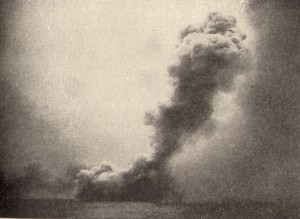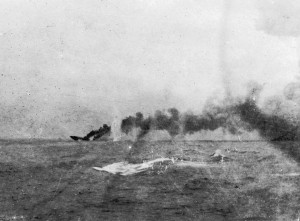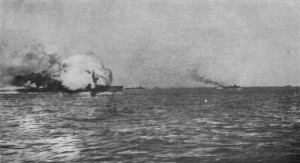31 May 1916. The German High Seas Fleet is coming out, hoping to draw out some of the British Grand Fleet and pounce on it before the rest of it can come up. Unknown to the Germans, the British, using the Room 40 decrypts they enjoyed thanks to the Russians’ having had the pluck and sense to strip SMS Magdeburg of her code books in 1914 and then the generosity to turn them over to the Royal Navy, knew precisely where they intended to go and what they intended to do. So Jellicoe got the entire Grand Fleet underway to meet them.
The stage was thus set for the Armageddon-style naval battle that every commander since Nelson had sought. Here a brief historical overview might be of assistance. Prior to Nelson, battle fleets fought and had for 140-plus years fought in line-ahead formation. To some extent it made sense because wooden warships mount their guns in broadside only, and those guns have only limited ability to be trained out of the strictly perpendicular to the keel. The ends of a wooden ship — especially the stern — are much thinner than its sides, and much shorter. So even though you might mount a few bow-chasers or stern-chasers so you wouldn’t be complete impotent, those guns represented only a tiny fraction of the ship’s total weight of firepower. To put some numbers on it, of a first-rate’s 98 or more heavy guns, ranging from 18-pounders to 32-pounders, maybe a total of eight or ten would be mounted outside of the broadside batteries. In line ahead, where each ship follows the one ahead of it as closely as it safely can, you concentrate and mutually reinforce the fleet’s individual broadsides, and you also prevent the opposing fleet’s ships from piercing the line and firing its concentrated broadside against the largely unprotected bow or (even worse) the stern, almost completely unprotected by heavy timbers.
Gentle Reader will rapidly perceive the logical development of this tactic, though, along the principle of sauce for the gander. Both fleets adopt the line ahead. Now, a fleet in line ahead is not going to be able effectively to pierce the opponent’s line along its length. That would produce a geometry looking like a cross-member tire iron. While the fleet piercing the line will be able to concentrate its fire on the ends of the ships between which it sails, the other fleet will be able to concentrate its fire on the ends of the ships nearest its line where pierced. Stymie, in other words. The dynamic is entirely different if you can, not pierce, but cross the opponent’s line ahead of it. It’s called “crossing the T,” and it’s the holy grail of battle line tactics. Of course, now you’ve crossed the T, what do you do? You’re still line ahead, only on the other side of your enemy, and now he “has the weather gauge of you,” meaning he is upwind of you, a crucially important tactical advantage in the era of square-rigged battle fleets.
The upshot of all of the above considerations was that from its formal adoption in the 1660s all the way up to the late 1700s, naval battles, at least when on the high seas where there wasn’t a lee shore you could run your enemy onto (as at Quiberon Bay, in 1759), tended to be indecisive. Oh sure, occasionally a ship would have the misfortune to be so disabled as not to be able to stay in line. She’d drift out on her own and be surrounded and captured. Beyond individual misfortune such as that, however, naval battles just didn’t decide a whole lot. That’s not to say sea power as such was indecisive, because it very much was. It’s just that the effectiveness of main battle fleets against each other was limited.
Still the line ahead made sense, by and large, and it made enough sense that the Royal Navy formally incorporated it into Fighting Instructions, its mandatory combat manual. Woe betide the captain who broke line. Woe betide the admiral who failed to maintain his battle line.
Until Nelson.
Nelson realized two things, one strategic and the other tactical. His strategic insight was that the line ahead was never going to produce a strategic-level result precisely because it could not be expected to produce a battle where one fleet was largely destroyed by the other. His tactical insight was that the virtues of the line of battle were strongest when the two fleets were of equal quality in seamanship and gunnery. But if one fleet was significantly the other’s superior, then it might well be able to sail sufficiently exactly as to pierce the enemy’s line in multiple places simultaneously, and the difference in gunnery would significantly reduce the damage inflicted while doing so. This would then place the better fleet’s ships close alongside their counterparts, where their superior gunnery stood the best chance of achieving decisive results. Nelson further realized that, after a dozen or so years of purge, guillotine, and neglect, the Royal Navy had attained that level of mastery over the French.
The validity of Nelson’s insights was proved dramatically at Trafalgar in 1805. Nelson divided his fleet into two squadrons, abandoned the line ahead to hoist the signal “general chase,” and then drove his fleet like two mailed fists into the straggling, disordered, bumbling combined French and Spanish fleets. There developed a general melee in which Nelson’s parting instruction to his captains that, “No captain can do very wrong who places his ship alongside that of a Frenchman,” bore fruit. Two-thirds of the combined fleet was sunk or captured that afternoon, and British hegemony at sea assured for another century-plus. Nelson died that day, but not before receiving the news of his victory.
From Trafalgar onward, every naval officer in every country dreamed of another Trafalgar. Mahan dreamed of it, and wrote it into his book. Fisher dreamed of it, and built Dreadnought and her descendants to make it happen. Tirpitz dreamed of it but was realist enough to understand it wasn’t likely against the British. Jellicoe dreamed of it; Scheer dreamed of it; Beatty dreamed of it.
And in May, 1916 it seemed as though it was to happen. Britain and Germany together floated dozens and dozens of massive Castles of Steel (to borrow Robert K. Massie’s book title), each capable of hurling up to a dozen massive armor-piercing shells, weighing anywhere from 900 to 1,800 pounds each, miles and miles, to fall onto the enemy’s decks, bulkheads, and hulls. Their populaces had internalized the image of knights clad in armor, smiting each other hip and thigh in noble combat.
Except it wasn’t quite so. Winston Churchill, First Lord of the Admiralty from 1910 until 1915, attempted to correct his fellow Members’ understanding. Two modern dreadnoughts in battle, he said, were not correctly thought of as two plated and mailed knights hacking at each other with swords, but rather as two eggs striking at each other with hammers. And by 1916 the hammers weren’t even the most dangerous threat. Mines and torpedoes, the former more than the latter, could explode beneath the giants’ armor belts, below the waterline, and in a matter of minutes destroy the work of years. As in fact happened to the brand-new dreadnought HMS Audacious, sunk by a mine in October, 1914, fourteen months after she was commissioned. Admiral Jellicoe, the Grand Fleet’s commander, fully realized the peril. Shortly after the war started he declared his belief that chasing a retreating German fleet back towards Germany was a mistake, as it was every bit as likely to be a ruse, to draw the British over minefields. He announced an intention to avoid falling into that trap (and his stated intention received the Admiralty Lords’ blessing, it should not be overlooked).
And so the fleets sailed towards each other, through the haze and fog banks of a North Sea early summer. The Germans had no idea of what was headed their way until the fleets’ respective scouts went to investigate a fishing trawler each sighted. Each fleet’s closest squadron just happened to be its battlecruisers, and here is where we get to this post’s title.
Battlecruisers were, like Dreadnought herself, an invention of Admiral Jackie Fisher. They had a dreadnought’s heavy guns, but they were to be fast, like jungle cats (in fact they were referred to, both in the press and in the fleet, in those terms). Now folks, the laws of physics apply with even greater brutality on the ocean than they do on land. You’ve got three things and you can’t have them all at once: guns, armor, and speed. If you want more of one you’re going to have to skimp on the others. That’s just the way it works. So Fisher chose to skimp on the armor leg of that triangle.
Fisher’s original vision had been a ship fast enough to catch any major ship it could out-gun, and by like token to run away from anything that could match or out-gun it. Logical enough, and indeed that is precisely how things worked out in the fall of 1914. German Admiral Maximilian von Spee’s Pacific Squadron had jumped a couple of elderly British cruisers off the coast of Chile and sent them to the bottom with the loss of all hands. So the Royal Navy dispatched two of its original battlecruisers, Invincible and Inflexible, to deal with Spee. On December 8, 1914, they caught him making a run at the Falklands and in an afternoon’s shooting destroyed nearly his entire squadron (taking not only Spee but his two young sons down).
But o! what a difference a word can make! Fisher permitted them to be called “battlecruisers,” and further permitted them to be regarded in the fleet as components of the battle fleet. They were to be the fleets’ “scouts.” But the fleet had scouts, you see. It had shoals of destroyers and full squadrons of actual cruisers. Ships that could out-run even a battlecruiser. Since a scout’s whole mission is to get close enough to the enemy to figure out what’s going on (recall, Gentle Reader, that radar was still 20 years or more in the future), you don’t want a scout you can’t afford to lose. Hard cheese on the expendable scouts, but there it is. In short, the very worst place for a battlecruiser is in a fleet battle formation, where its speed is negated (it can’t maneuver faster than the slowest unit in the fleet), and where it will necessarily be exposed to heavy and concentrated shelling from the opposing fleet. And that’s precisely where the British put theirs.
Without going into too great detail, Jellicoe managed to cross Scheer’s T not once, but twice that day. With lousy visibility, poor communications (flag hoists were nearly useless and the day’s primitive radio sets tended to be knocked out the concussion of the ship’s own guns firing), and the press of fleets maneuvering at well over 20 knots each, Jellicoe managed one of the greatest sustained feats of seamanship in all naval history. At a cost, a ferocious cost. Full three of Britain’s deadly cats went down, each one the victim of a German shell finding its magazine.
In the below picture, somewhere at the bottom of that enormous cloud of smoke and flame, is what used to be HMS Queen Mary.
And here’s HMS Indefatigable going down:
And this is what is about to become the former HMS Invincible (the Royal Navy’s original battlecruiser):
And at the end of the day, after Scheer for the second time had ordered Gefechtskehrtwendung (“battle turn”) away from the Grand Fleet, to make a run for home, Jellicoe, true to his previously stated and endorsed intention, did not follow. The public and to some extent the brass never forgave him. He was booted upstairs and Admiral Beatty, who commanded the battlecruisers that day, was given command of the fleet.
The High Seas Fleet never came out again in force until it did so to surrender. For all of Tirpitz’s brilliance as a political operative and administrator, he never successfully addressed the strategic conundrum facing the Imperial German Navy: It was bottled up in the North Sea and unless it destroyed the British fleet — which no one thought it could do — there it was going to stay. Meanwhile the British fleet enjoyed the freedom of the world’s seas, as did its enormous merchant fleet. Until the advent of the submarine. Mahan’s fleet-in-being theory could not exist, in short, without reference to the hard facts of geography.
What did the British learn from Jutland? Not enough to avoid building HMS Hood as a battlecruiser, and not enough to pull her out of service once built to bulk up her armor. And not enough not once again to use the wrong tools for the job, sending her to her doom against Bismarck in 1941.



